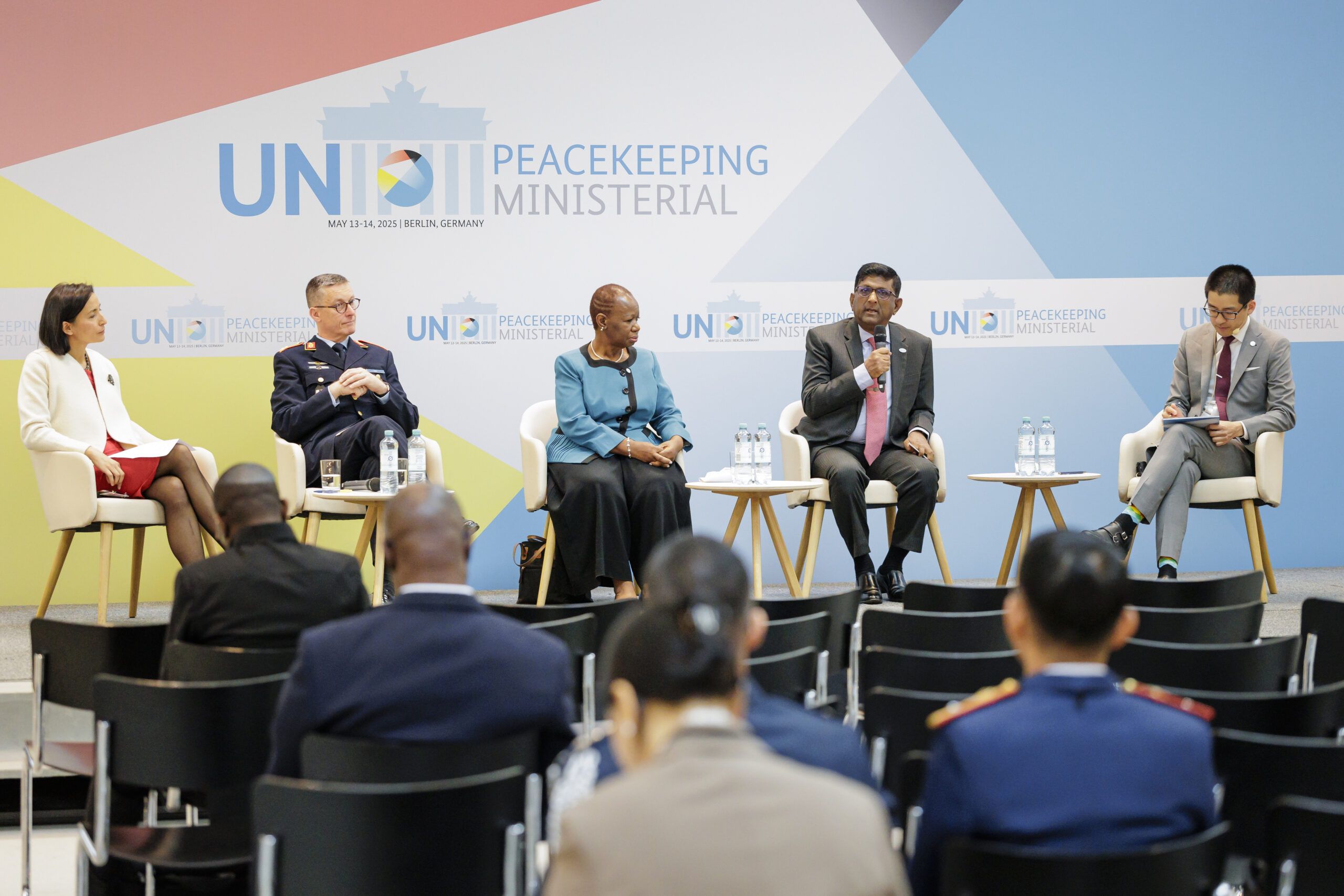Reflections on the 2025 Peacekeeping Ministerial

Berlin hosted the 2025 Peacekeeping Ministerial over May 13-14—the sixth such event to follow the 2015 Leader’s Summit on Peacekeeping—and on paper it was a resounding success. During the two-day meeting, 74 member states made specific pledges to United Nations (UN) peacekeeping operations, including 88 military and police units, specialized training, and investments in emerging technologies and strategic communications.[1] The German government deserves praise both for so smoothly organizing the meeting but also for broadening its focus beyond the pledging sessions to include discussions on the future direction of peacekeeping operations and on thematic issues of relevance to contemporary peace operations.
What was missing, however, was a meta-reflection on the continued relevance of the ministerial process. Realistically, are most of the units pledged ever going to be deployed? After all, we are in the midst of a decade-long retrenchment of peacekeeping operations that shows no sign of abating. And on the day before the ministerial, the secretary-general called for a 20 percent cut in the level of staffing in the Department of Peace Operations (DPO). Moreover, the ministerial reinforces a force generation process that, at its core, remains the one that the High-level Independent Panel on Peace Operations (HIPPO) described ten years ago as having “struggled to get sufficient forces on the ground quickly enough and relies on underresourced uniformed capabilities with little or no interoperability and weak command and control.”
In his keynote remarks at the ministerial, Secretary-General Guterres stated that the review of peace operations requested in the Pact for the Future will “examine how we can make peacekeeping operations more adaptable, flexible and resilient—while recognizing the limitations in situations where there is little or no peace to keep.”[2] Yet throughout the tenure of this secretary-general, the peace and security pillar of the Secretariat has not demonstrated the ability to engage in honest self-reflection, to acknowledge faults, or to undertake meaningful reform. This has been demonstrated time and time again, beginning with the 2017 internal review team on the peace and security architecture and through the development of the 2023 New Agenda for Peace.[3] We should therefore not be surprised if the peace operations review, which will also be conducted internally, ultimately concludes that no reform is needed because peace operations remain an effective tool and that challenges experienced by peace operations in recent years are attributed to geopolitical divisions amongst member states.
Whether a meaningful reflection in the remainder of the secretary-general’s term is possible is also questionable given that the secretary-general has actively undermined the role of the UN in peace and security. Ten years ago, the High-level Independent Panel on Peace Operations warned against the emerging primacy of the military in peacekeeping operations[4] and, instead, called for the primacy of politics to guide efforts to prevent and resolve violent conflict and for UN peace operations to play a leading role in the facilitation of political solutions.[5] Instead of heeding this call, Secretary-General Guterres has doubled down on the militarization of peacekeeping by not only turning the UN away from peacemaking but also relegating the UN to a supporting role as a logistical and financial service provider to regional operations undertaking peace enforcement and counterterrorism organizations.[6] The ministerial process, with its focus on military capabilities, has only served to reinforce the primacy of the military in peacekeeping operations when this militarization is one of the underlying reasons for why missions struggle today.
UN peacekeeping has involved military components from its earliest days, but these military capabilities were intended to be used in support of political objectives, such as the efforts of UN mediators and special envoys. The three principles of peacekeeping—consent of the parties, impartiality, and non-use of force except in self-defense—were intended to leverage the unique legitimacy of the UN and maximize its comparative advantage in conflict resolution. In the years since the introduction of the protection of civilians mandate in 1999, missions have increasingly become militarized in that their focus is now no longer the enabling of political strategies for the resolution of conflict, but rather on the proactive use of force to protect the host government and civilians. Missions no longer adhere to the principles in any meaningful way; they are no longer impartial, they focus on maintaining the consent of the host government, and they are encouraged to use force. This shift in doctrine has taken place despite the fact that we have ample evidence and experience to demonstrate that there is no military solution to conflict.[7] Missions that focus on militarized efforts reduce the incentives for political elites to find long-term political solutions.[8] This locks missions into the essentially Sisyphean task of providing physical protection of civilians without being able to develop or implement effective exit strategies.[9]
One of the breakout sessions during the ministerial reinforced the importance of peacebuilding as part of peacekeeping. But this is not new; it was a key aspect of the 1992 Agenda for Peace, and the 2023 revision of the UN integrated assessment and planning policy specifically framed the work of UN peace operations in the context of peacebuilding and sustaining peace. In practice, however, UN peacekeeping operations have shifted decisively in the past decade from tools of promoting peacebuilding to instruments of stabilization. The distinction is an important one. The UN conception of peacebuilding is rooted in the idea that democracy, human rights, and the rule of law are the foundations of peaceful societies; it therefore promotes the liberal conception of peace that had been dominant since the end of the Cold War. Stabilization, on the other hand, prioritizes the interests of the host government and focuses on the use of force and coercion by state institutions to suppress violence; it therefore promotes an alternative, illiberal, vision of peace championed by China and Russia.[10] The militarization of UN missions in the Democratic Republic of the Congo, Mali, and the Central African Republic has instrumentalized these missions into tools of regime preservation in which the use of force by missions is disproportionately applied against opponents of the host state authorities and has undermined the ability of those missions to effectively promote liberal democratic norms.
Peacekeeping has not been a static enterprise; it has adapted over time to the changing nature of conflict and to the desires of member states and the Secretariat. But history has shown that, in attempting to meet changing demands, peacekeeping has on several occasions made costly missteps that have required reflection and repositioning, including after the failures of missions in Bosnia, Rwanda, and Somalia in the 1990s. In the past two decades, UN peacekeeping sought to adapt to the demands of its member states in pursuing a more robust approach focused on the physical protection of civilians. But this pivot to stabilization to meet short-term demand has had a pernicious effect on the long-term relevance of the UN in peace and security.It has compromised the fundamental principles of UN peacekeeping and, in doing so, has squandered the impartiality that underpinned the comparative advantage of the UN in conflict management and resolution.
The Secretariat and Member States can take several steps in the coming months to begin reversing this trend. The fact that no host for the next ministerial was announced during the 2025 peacekeeping ministerial presents an opportunity to wind down the ministerial process on a high note ten years after it was launched. Member states should use the 2026 meeting of the Working Group on Contingent-Owned Equipment and the quadrennial review of rates of reimbursement more strategically to consider how to modernize the uniformed personnel framework to meet contemporary requirements. At the same time, they should work to ensure that the review of peace operations yields a useful reflection on what the role of UN peacekeeping—and peace operations more broadly—ought to be in our brave new world. To restore the relevance of the UN requires member states to not only reaffirm the principles of peacekeeping, but to also ensure that their actions match their rhetoric. The concept of the primacy of politics should not be treated as an aphorism, but as a guiding principle for the design and implementation of mandates. Although effective support to the protection of civilians is crucial for ensuring the legitimacy of the UN, the UN must better manage expectations and place sufficient emphasis on aspects of protection of civilians other than physical protection. The UN must also reconceptualize its approach to supporting non-UN forces to ensure that such efforts support a credible political solution and can meaningfully contribute to sustaining peace. And the Secretariat must have the courage to say “no” when asked to undertake activities at odds with its principles and to be honest with UN member states when its approaches are not achieving the desired effect.
This is not a call for going “back to basics.” It is a push for the UN to acknowledge how choices made over the past few decades to meet the demands of member states drove multidimensional peacekeeping operations away from a focus on peacemaking and peacebuilding towards stabilization, therefore transforming a tool for the promotion of liberal peace into an instrument of illiberal peace. The UN can, of course, attempt to follow the political winds, bending to the rise of authoritarianism and the turn away from the tenets of the liberal international order in adapting its doctrinal and administrative frameworks to more effectively support stabilization. But it must understand that to chart such a course would be to repudiate the ideals at the heart of the UN and the principles and purposes enshrined in the UN Charter.
###
[1] Vibhu Mishra, “In Berlin, broad backing for UN peacekeeping as global threats mount,” UN News, May 14, 2025, https://news.un.org/en/story/2025/05/1163246.
[2] Antonio Guterres, “Secretary-General’s remarks to the Ministerial Meeting on the Future of Peacekeeping,” United Nations, May 13, 2025, https://www.un.org/sg/en/content/sg/statement/2025-05-13/secretary-generals-remarks-the-ministerial-meeting-the-future-of-peacekeeping-bilingual-delivered-scroll-down-for-all-english-and-all-french.
[3] Eugene Chen et al., “Managing Opportunities, Challenges, and Expectations for the New Agenda for Peace,” NYU Center on International Cooperation, May 17, 2023, https://cic.nyu.edu/resources/managing-opportunities-challenges-and-expectations-for-the-new-agenda-for-peace/.
[4] Jean Arnault, “A Background to the Report of the High-Level Panel on Peace Operations,” NYU Center on International Cooperation (blog), August 6, 2015, https://cic.nyu.edu/resources/a-background-to-the-report-of-the-high-level-panel-on-peace-operations/.
5] United Nations, “Report of the High-Level Independent Panel on Peace Operations on Uniting Our Strengths for Peace: Politics, Partnership and People (A/70/95–S/2015/446),” June 17, 2015, https://undocs.org/en/a/70/95.
[6] Antonio Guterres, “Secretary-General’s Remarks to the General Assembly Consultation on Our Common Agenda/Summit of the Future,” United Nations General Assembly, February 13, 2023.
[7] Lawrence Freedman, “The Age of Forever Wars,” Foreign Affairs 104, no. 3 (April 14, 2025): 108–21.
[8] https://doi.org/10.1163/19426720-02902008.
[9] > Paul D. Williams, “Multilateral Counterinsurgency in East Africa,” Small Wars & Insurgencies, July 2, 2024, 1–30, https://doi.org/10.1080/09592318.2024.2372712.
[10] Roland Paris, “The Future of UN Peace Operations: Pragmatism, Pluralism or Statism?,” International Affairs (August 5, 2024): iiae182, https://doi.org/10.1093/ia/iiae182.
Stay Connected
Subscribe to our newsletter and receive regular updates on our latest events, analysis, and resources.
"*" indicates required fields
